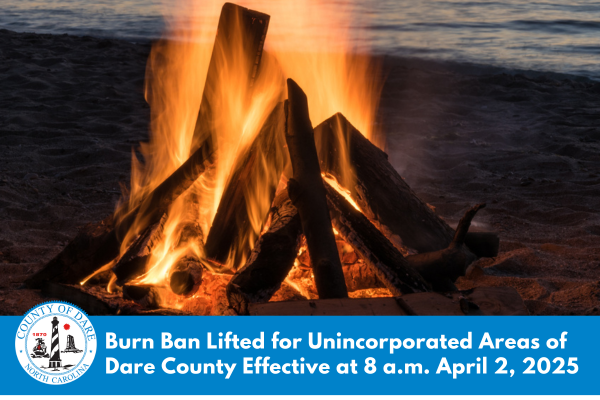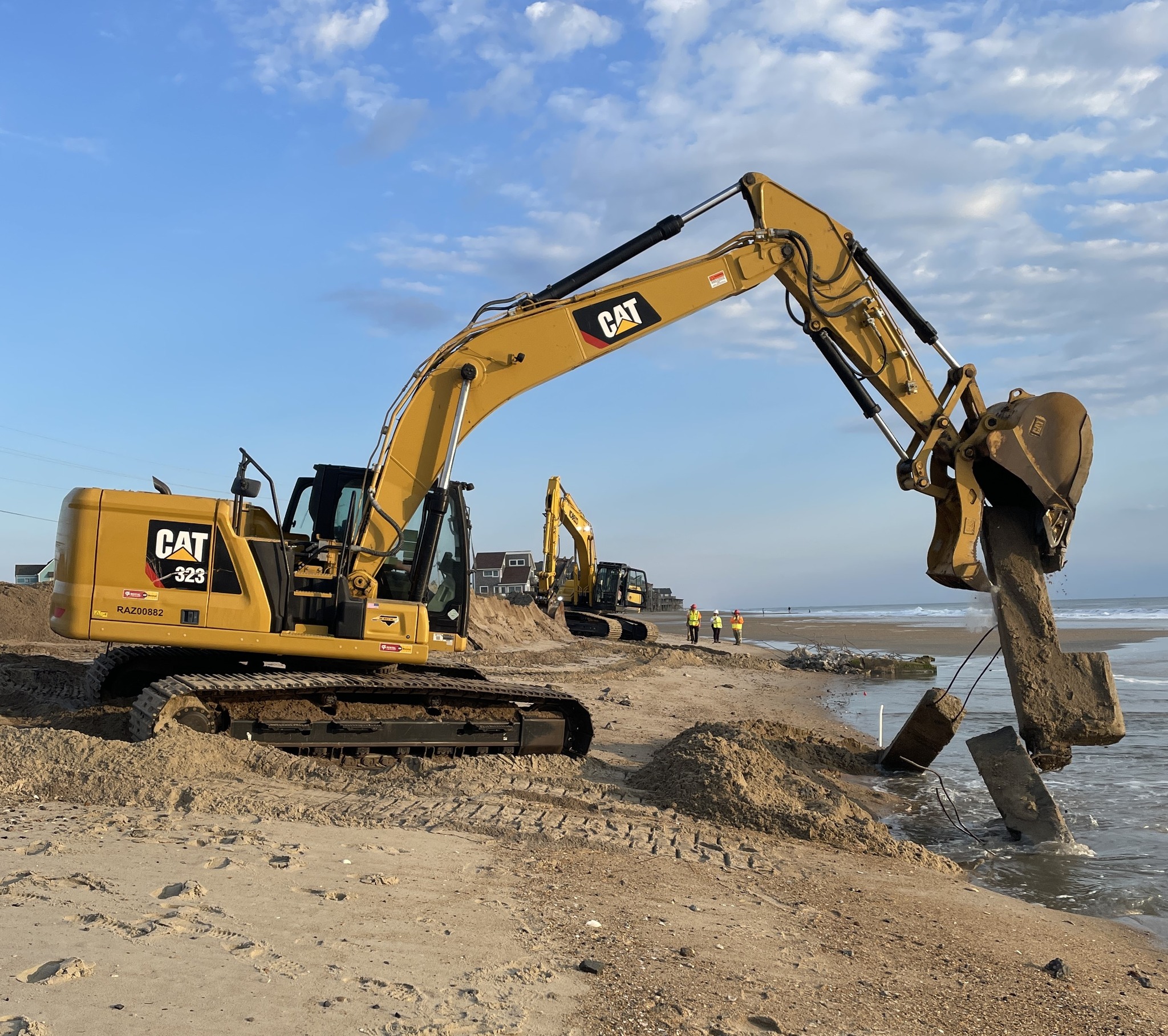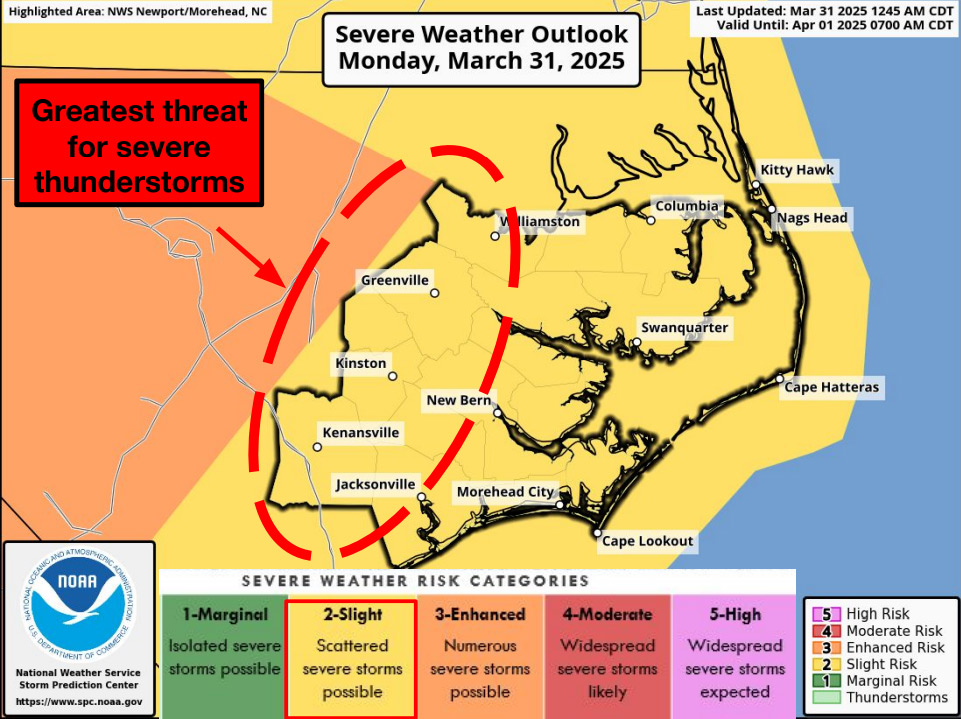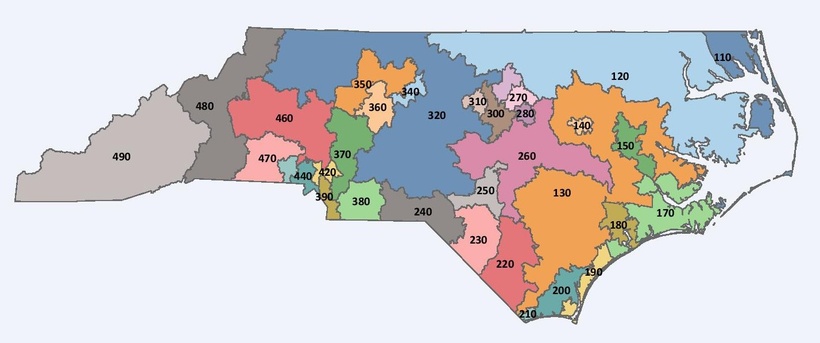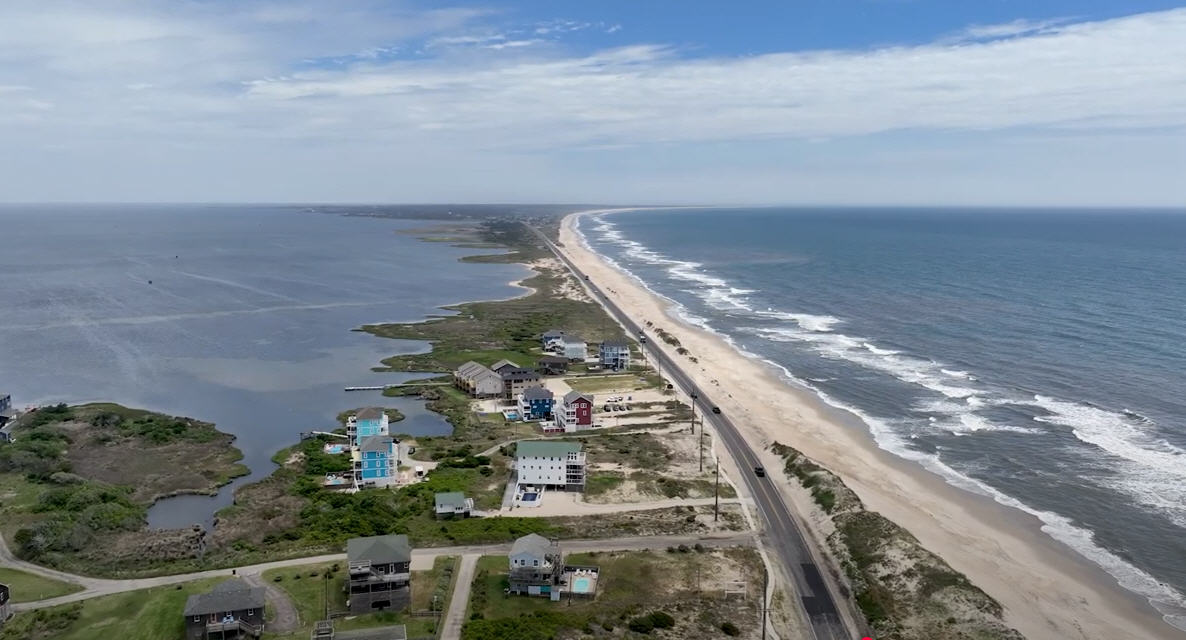Students learn a lesson outside the classroom as they help restore Durant’s Point
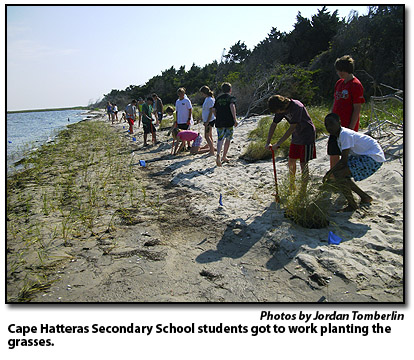
By JORDAN TOMBERLIN
By JORDAN TOMBERLIN
Any Hatteras local can tell you the importance of Hatteras Harbor. It’s the lifeblood of a community, both culturally and economically, and not having it would stifle one of the most popular and productive charter and commercial fishing fleets in the state.
With that in mind, students from Cape Hatteras Secondary School of Coastal Studies, in partnership with the North Carolina Coastal Federation, took a big step last week toward protecting and preserving that invaluable island resource.
On Friday, May 20, the seventh-grade students, eighth-grade Builder’s Club officers, and the high school ecology class from CHSS, along with their teachers Tracy Shisler and Amber Bradshaw, met at Oden’s Dock for a hands-on lesson in coastal preservation.
They spent the morning kayaking across the channel and planting marsh grasses along the banks of Durant’s Point, just north of the mouth of the harbor, in an effort to create a “living shoreline” that will help stabilize the quickly eroding coast.
The project, funded by a grant from the National Oceanic and Atmospheric Association (NOAA) in conjunction with the Restoring America’s Estuaries (RAE) program, allowed for the building of a new, low-profile sill that tied into the existing revetment built by the Army Corps of Engineers, as well as the purchase of the 8,000 plants that students and other volunteers planted last week.
The primary goal of the project was to construct a sill that would slow (not stop) overwash and to plant grasses that would not only stabilize the coastline and prevent erosion, but would also improve marine habitat and water quality.
Total Marine of Wanchese and Cape Dredging of Buxton constructed the sill during the first two weeks of the month. According to Darren Burrus of Cape Dredging, the construction required two barges, three excavators and a backhoe, as well as a rubber-track truck used to transport the materials down the beach to the site.
Fleckenstein said that, while they have used various materials to create sills in the past, the fact that this was such a high-energy site necessitated the use of granite, which they obtained from Vulcan Materials in Elizabeth City.
The plants, a mix of salt meadow hay and smooth cord grass, were delivered to the Breakwater Inn on Tuesday, May 17, and were transported over to Durant’s Point by volunteers, where adult community members planted around 2,000 of them on Wednesday, May 18.
A secondary, though very important, goal was community outreach and involvement.
Though the project was funded through a federal grant, it still required a good deal of community organization and support.
Albert and Larry Bonney allowed Total Marine and Cape Dredging to use their property, located just across from the Village Marina, to store and load the granite for the sill, and Hatteras local Lynne Foster helped organize Wednesday’s volunteer effort to ferry the flats of grass to Durant’s Point and plant the first batch.
In addition, Kitty Hawk Kites, as well as Paul and Maria Rosell of Hatteras Parasail and Watersports donated kayaks for the students, and the Rosells also provided instruction on how to use the kayaks, as well as their launching area.
Student education and involvement were a particularly important goal of the project.
“Education and restoration go hand in glove,” said Erin Fleckenstein, a coastal scientist with the North Carolina Coastal Federation. She said that the Coastal Federation seeks to use projects such as this one to “foster the next generation of coastal stewards,” noting that involvement breeds ownership, and that students will be more likely to continue learning about and preserving their natural resources if they have already been involved in the process.
And the students were involved in this particular project from the very beginning.
Over the course of the school year, Sara Hallas, a scientist with the Coastal Federation, actually came to CHSS three times to teach the students about the importance of estuaries and what’s harming them, the causes and effects of coastline erosion, and alternative ways to preserve and maintain the land and resources.
She even brought seeds for the marsh grasses they would be planting, so that the students could learn first-hand how the plants grew and why they would help stabilize the harbor. And, while Hallas said that it was unlikely that any of grasses planted on Friday had been grown by students (It’s pretty difficult to grow marsh grass under fluorescent lights in a classroom.), the knowledge and experience they gained would nonetheless deepen their understanding of the environment and the value of their work.
Once the students had kayaked across the creek, arrived on Durant’s Point, and carried the remaining flats of grass to the site, Fleckenstein gathered them around her, explaining the purpose and importance of the project. She explained how the sill worked, why they had used the materials they used to construct it, why they were planting the grasses they were planting, and how they would help stabilize the coastline.
Then, she and another volunteer demonstrated how to plant the grasses, and the students worked in pairs on the project. They were only able to work until noon, so they couldn’t finish the job. It is hoped that community groups will help with the remaining plants in the coming days.
“Ideally,” said Hallas, “the goal is to get them to see what they’ve been learning about in the classroom.”
“It’s about seeing a site washing away,” she continued. “It’s about seeing the value of Hatteras Harbor and working to protect it.”
Talking to the students, it was clear that they appreciated the opportunity to get out of the classroom and into the field—even if they weren’t always terribly enthusiastic about the work. At one point, a very pregnant Fleckenstein joked with one of the students that she was eight months pregnant and working faster than he was.
All things considered, though, it was a good opportunity for students to apply classroom knowledge to real, valuable community projects—to see that what they’re learning can help them protect and preserve their island and its culture.
For more information on the project follow this link:
Any Hatteras local can tell you the importance of Hatteras Harbor. It’s the lifeblood of a community, both culturally and economically, and not having it would stifle one of the most popular and productive charter and commercial fishing fleets in the state.
With that in mind, students from Cape Hatteras Secondary School of Coastal Studies, in partnership with the North Carolina Coastal Federation, took a big step last week toward protecting and preserving that invaluable island resource.
On Friday, May 20, the seventh-grade students, eighth-grade Builder’s Club officers, and the high school ecology class from CHSS, along with their teachers Tracy Shisler and Amber Bradshaw, met at Oden’s Dock for a hands-on lesson in coastal preservation.
They spent the morning kayaking across the channel and planting marsh grasses along the banks of Durant’s Point, just north of the mouth of the harbor, in an effort to create a “living shoreline” that will help stabilize the quickly eroding coast.
The project, funded by a grant from the National Oceanic and Atmospheric Association (NOAA) in conjunction with the Restoring America’s Estuaries (RAE) program, allowed for the building of a new, low-profile sill that tied into the existing revetment built by the Army Corps of Engineers, as well as the purchase of the 8,000 plants that students and other volunteers planted last week.
The primary goal of the project was to construct a sill that would slow (not stop) overwash and to plant grasses that would not only stabilize the coastline and prevent erosion, but would also improve marine habitat and water quality.
Total Marine of Wanchese and Cape Dredging of Buxton constructed the sill during the first two weeks of the month. According to Darren Burrus of Cape Dredging, the construction required two barges, three excavators and a backhoe, as well as a rubber-track truck used to transport the materials down the beach to the site.
Fleckenstein said that, while they have used various materials to create sills in the past, the fact that this was such a high-energy site necessitated the use of granite, which they obtained from Vulcan Materials in Elizabeth City.
The plants, a mix of salt meadow hay and smooth cord grass, were delivered to the Breakwater Inn on Tuesday, May 17, and were transported over to Durant’s Point by volunteers, where adult community members planted around 2,000 of them on Wednesday, May 18.
A secondary, though very important, goal was community outreach and involvement.
Though the project was funded through a federal grant, it still required a good deal of community organization and support.
Albert and Larry Bonney allowed Total Marine and Cape Dredging to use their property, located just across from the Village Marina, to store and load the granite for the sill, and Hatteras local Lynne Foster helped organize Wednesday’s volunteer effort to ferry the flats of grass to Durant’s Point and plant the first batch.
In addition, Kitty Hawk Kites, as well as Paul and Maria Rosell of Hatteras Parasail and Watersports donated kayaks for the students, and the Rosells also provided instruction on how to use the kayaks, as well as their launching area.
Student education and involvement were a particularly important goal of the project.
“Education and restoration go hand in glove,” said Erin Fleckenstein, a coastal scientist with the North Carolina Coastal Federation. She said that the Coastal Federation seeks to use projects such as this one to “foster the next generation of coastal stewards,” noting that involvement breeds ownership, and that students will be more likely to continue learning about and preserving their natural resources if they have already been involved in the process.
And the students were involved in this particular project from the very beginning.
Over the course of the school year, Sara Hallas, a scientist with the Coastal Federation, actually came to CHSS three times to teach the students about the importance of estuaries and what’s harming them, the causes and effects of coastline erosion, and alternative ways to preserve and maintain the land and resources.
She even brought seeds for the marsh grasses they would be planting, so that the students could learn first-hand how the plants grew and why they would help stabilize the harbor. And, while Hallas said that it was unlikely that any of grasses planted on Friday had been grown by students (It’s pretty difficult to grow marsh grass under fluorescent lights in a classroom.), the knowledge and experience they gained would nonetheless deepen their understanding of the environment and the value of their work.
Once the students had kayaked across the creek, arrived on Durant’s Point, and carried the remaining flats of grass to the site, Fleckenstein gathered them around her, explaining the purpose and importance of the project. She explained how the sill worked, why they had used the materials they used to construct it, why they were planting the grasses they were planting, and how they would help stabilize the coastline.
Then, she and another volunteer demonstrated how to plant the grasses, and the students worked in pairs on the project. They were only able to work until noon, so they couldn’t finish the job. It is hoped that community groups will help with the remaining plants in the coming days.
“Ideally,” said Hallas, “the goal is to get them to see what they’ve been learning about in the classroom.”
“It’s about seeing a site washing away,” she continued. “It’s about seeing the value of Hatteras Harbor and working to protect it.”
Talking to the students, it was clear that they appreciated the opportunity to get out of the classroom and into the field—even if they weren’t always terribly enthusiastic about the work. At one point, a very pregnant Fleckenstein joked with one of the students that she was eight months pregnant and working faster than he was.
All things considered, though, it was a good opportunity for students to apply classroom knowledge to real, valuable community projects—to see that what they’re learning can help them protect and preserve their island and its culture.
For more information on the project follow this link:
Any Hatteras local can tell you the importance of Hatteras Harbor. It’s the lifeblood of a community, both culturally and economically, and not having it would stifle one of the most popular and productive charter and commercial fishing fleets in the state.
With that in mind, students from Cape Hatteras Secondary School of Coastal Studies, in partnership with the North Carolina Coastal Federation, took a big step last week toward protecting and preserving that invaluable island resource.
On Friday, May 20, the seventh-grade students, eighth-grade Builder’s Club officers, and the high school ecology class from CHSS, along with their teachers Tracy Shisler and Amber Bradshaw, met at Oden’s Dock for a hands-on lesson in coastal preservation.
They spent the morning kayaking across the channel and planting marsh grasses along the banks of Durant’s Point, just north of the mouth of the harbor, in an effort to create a “living shoreline” that will help stabilize the quickly eroding coast.
The project, funded by a grant from the National Oceanic and Atmospheric Association (NOAA) in conjunction with the Restoring America’s Estuaries (RAE) program, allowed for the building of a new, low-profile sill that tied into the existing revetment built by the Army Corps of Engineers, as well as the purchase of the 8,000 plants that students and other volunteers planted last week.
The primary goal of the project was to construct a sill that would slow (not stop) overwash and to plant grasses that would not only stabilize the coastline and prevent erosion, but would also improve marine habitat and water quality.
Total Marine of Wanchese and Cape Dredging of Buxton constructed the sill during the first two weeks of the month. According to Darren Burrus of Cape Dredging, the construction required two barges, three excavators and a backhoe, as well as a rubber-track truck used to transport the materials down the beach to the site.
Fleckenstein said that, while they have used various materials to create sills in the past, the fact that this was such a high-energy site necessitated the use of granite, which they obtained from Vulcan Materials in Elizabeth City.
The plants, a mix of salt meadow hay and smooth cord grass, were delivered to the Breakwater Inn on Tuesday, May 17, and were transported over to Durant’s Point by volunteers, where adult community members planted around 2,000 of them on Wednesday, May 18.
A secondary, though very important, goal was community outreach and involvement.
Though the project was funded through a federal grant, it still required a good deal of community organization and support.
Albert and Larry Bonney allowed Total Marine and Cape Dredging to use their property, located just across from the Village Marina, to store and load the granite for the sill, and Hatteras local Lynne Foster helped organize Wednesday’s volunteer effort to ferry the flats of grass to Durant’s Point and plant the first batch.
In addition, Kitty Hawk Kites, as well as Paul and Maria Rosell of Hatteras Parasail and Watersports donated kayaks for the students, and the Rosells also provided instruction on how to use the kayaks, as well as their launching area.
Student education and involvement were a particularly important goal of the project.
“Education and restoration go hand in glove,” said Erin Fleckenstein, a coastal scientist with the North Carolina Coastal Federation. She said that the Coastal Federation seeks to use projects such as this one to “foster the next generation of coastal stewards,” noting that involvement breeds ownership, and that students will be more likely to continue learning about and preserving their natural resources if they have already been involved in the process.
And the students were involved in this particular project from the very beginning.
Over the course of the school year, Sara Hallas, a scientist with the Coastal Federation, actually came to CHSS three times to teach the students about the importance of estuaries and what’s harming them, the causes and effects of coastline erosion, and alternative ways to preserve and maintain the land and resources.
She even brought seeds for the marsh grasses they would be planting, so that the students could learn first-hand how the plants grew and why they would help stabilize the harbor. And, while Hallas said that it was unlikely that any of grasses planted on Friday had been grown by students (It’s pretty difficult to grow marsh grass under fluorescent lights in a classroom.), the knowledge and experience they gained would nonetheless deepen their understanding of the environment and the value of their work.
Once the students had kayaked across the creek, arrived on Durant’s Point, and carried the remaining flats of grass to the site, Fleckenstein gathered them around her, explaining the purpose and importance of the project. She explained how the sill worked, why they had used the materials they used to construct it, why they were planting the grasses they were planting, and how they would help stabilize the coastline.
Then, she and another volunteer demonstrated how to plant the grasses, and the students worked in pairs on the project. They were only able to work until noon, so they couldn’t finish the job. It is hoped that community groups will help with the remaining plants in the coming days.
“Ideally,” said Hallas, “the goal is to get them to see what they’ve been learning about in the classroom.”
“It’s about seeing a site washing away,” she continued. “It’s about seeing the value of Hatteras Harbor and working to protect it.”
Talking to the students, it was clear that they appreciated the opportunity to get out of the classroom and into the field—even if they weren’t always terribly enthusiastic about the work. At one point, a very pregnant Fleckenstein joked with one of the students that she was eight months pregnant and working faster than he was.
All things considered, though, it was a good opportunity for students to apply classroom knowledge to real, valuable community projects—to see that what they’re learning can help them protect and preserve their island and its culture.
For more information on the project follow this link:
Subject
Name
(required, will not be published)
(required, will not be published)
City :
State :
Your Comments:
May be posted on the Letters to the Editor page at the discretion of the editor.
May be posted on the Letters to the Editor page at the discretion of the editor.
May be posted on the Letters to the Editor page at the discretion of the editor.
May be posted on the Letters to the Editor page at the discretion of the editor.





